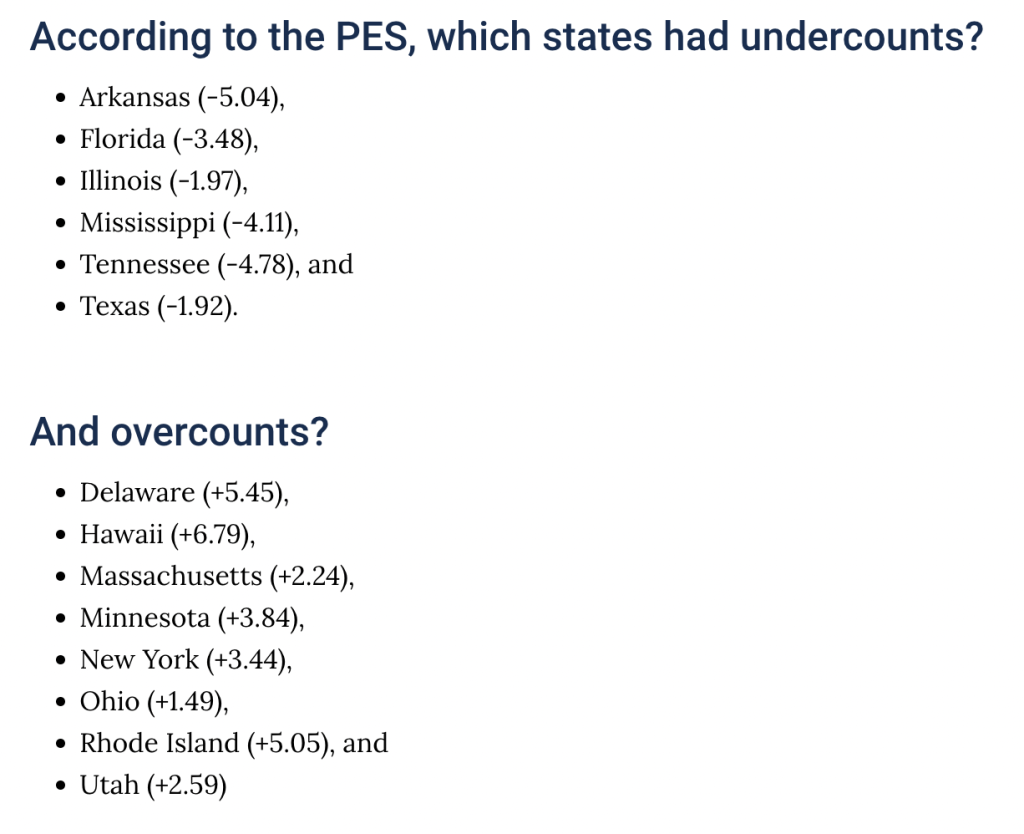The 2020 Census admits having undercounted in six states while it overcounted in eight. Oddly enough, most of the undercounted states were red states, and most of the overcounts were in blue states. Census numbers are only surveyed once every ten years. The implications for errors of this magnitude are significant for voter representation, especially since citizens must wait another ten years to redo the count.
According to the census website, "data collected by the census determine[s] the number of seats each state has in the U.S. House of Representatives (a process called apportionment) and is also used to adjust or redraw electoral districts based on where populations have increased or decreased." By comparison, the last census performed in 2010 produced no statistically significant undercount or overcount. Neither did the one prior to that in the year 2000.
The census breaks the nation down into four separate regions; Northeast, South, Midwest, and West. The 2020 Post-Enumeration Survey (PES) shows the following results concerning the erroneous counts.
 Census Errors/2020
Census Errors/2020
A more detailed graph showing the statistical errors can be found in the 2020 Post-Enumeration Survey Estimation Report, pictured below. The blue segments indicate Overcounts, and undercounts are indicated by the orange segments:
 census graph/Statistical errors
census graph/Statistical errors
So let's look at what these numbers mean in the real world. According to Hans Von Spakovsky with the Heritage Foundation, Rhode Island and Minnesota were overcounted by 5.05% and 3.84%, respectively, "which allowed each of them to keep a congressional seat to which they are not entitled." Delaware shows the highest overcount at 5.45%. Additionally, Spakovsky writes, Minnesota "would have lost a congressional seat during reapportionment if it had 26 fewer residents; the survey shows the state was overcounted by 216,971 individuals. Similarly, Rhode Island would have lost a seat if the Census Bureau had counted 19,000 fewer residents. It turns out that the state was overcounted by more than 55,000 individuals." Colorado was also awarded a seat that should not have been awarded due to the count. In short, the states with the overcounts will now have more representation in Congress than they deserve.
Similarly, the undercounts are equally impactful. The Census Bureau results show an undercount in Texas of close to 2%. Texas needed only 189,000 more people to gain another congressional seat. An undercount of 2% in Texas is equivalent to more than half a million Texans. It turns out Texas had the numbers to gain another seat. Florida was also cheated out of another seat. Arkansas had the largest percentage undercount at 5.04%, representing over 150,000 residents.
The census also affects federal funding to states. Simply stated, overcounted states will receive higher funding dollars than undercounted states because funding is based on population size. Undercounted states will be cheated of funding.
The worst part about the errors is there is no Constitutional, legal, or practical remedy. It boils down to being one big whoopsie with some pretty impactful consequences for the electorates of the affected states. One example surfaced in Harris County, Texas, where census-driven redistricting shifted every precinct "into Democratic strongholds." Census numbers can move mountains in the political world, and activist groups are ready to exploit the numbers.
The census data drive other important aspects of state governance besides apportionment, funding, and redistricting. States use those numbers to plan new roads, hospitals, schools, and other public sector investments. Businesses also use those numbers to inform their strategic planning. Census data also impacts emergency response and serves as a database for population migration and housing planning. Emergency response planning requires "demographic details from the census to assist epidemiologists and public health personnel in everything from tracking disease outbreaks, to combating the opioid epidemic, to improving child health."
The statistical errors were found as a result of post-census bureau interviews. The census bureau uses the post-census interview answers and compares those answers with the original census data.


